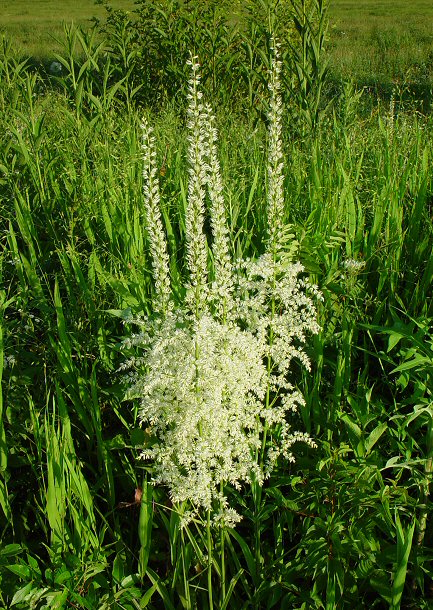Stenanthium gramineum (Ker Gawl.) Morong
Featherbells

Native
CC = 8
CW = 0
MOC = 23
© DETenaglia
Stenanthium gramineum (Ker Gawl.) MorongFeatherbells | |
 |
Native CC = 8 CW = 0 MOC = 23 |
© DETenaglia |
|
Family - Liliaceae Habit - Perennial forb, with the stem bases somewhat bulbous-thickened and coated by dense parallel fibers formed from the decayed remains of previous years' leaf bases. Stems - Erect, to 1.5 m, unbranched below the inflorescence, glabrous.
Leaves - Numerous, glabrous, mostly basal, those on the aerial stems greatly reduced and mostly bractlike, the basal leaves 20-45 cm long, linear, flat or somewhat corrugated.
Inflorescences - Terminal panicles of numerous flowers, the lower branches with functionally staminate flowers, the remainder with mostly functionally pistillate or perfect flowers.
Flowers - Flowers with stalks 1-3 mm long, subtended by small bracts, nodding, none of them replaced by bulblets. Perianth 4-10 mm long, the sepals and petals free, narrowly lanceolate, white to greenish white. Stamens 6, fused to the base of the perianth. Styles 3, each with a small stigma. Ovary superior, with 3 locules, each with 4-10 ovules.
Fruits - Capsules 10-15 mm long, ovoid, deeply 3-lobed, the lobes beaked with the persistent styles. Flowering - June - September. Habitat - Bottomland forests, rich wooded slopes, base of wooded bluffs, streambanks, wet prairies, grassy banks along railroads, roadsides. Typically on acid soils. Origin - Native to U.S. Lookalikes - None. Other info. - This strikingly beautiful species is found scattered in Missouri, most commonly in the Ozark region. It also occurs throughout much of the eastern continental U.S. but is nowhere common. When in flower it is impossible to mistake for anything else, with its large panicles of white flowers for which the term "featherbells" seems somehow appropriate. Vegetatively the plant can be difficult to identify and may even be mistaken for a grass by a casual observer. This plant would make a good cultivated species and would require little care once established. Photographs taken off Hwy 60, Shannon County, MO., 7-3-03 (DETenaglia); also at Millstream Gardens Conservation Area, Madison County, MO, 7-4-2017 (SRTurner). |